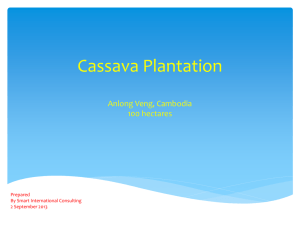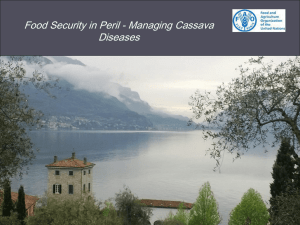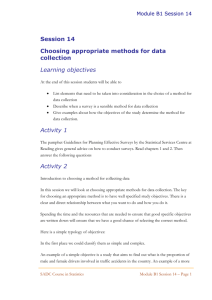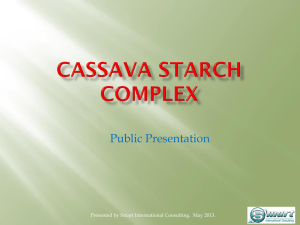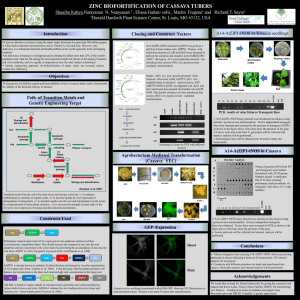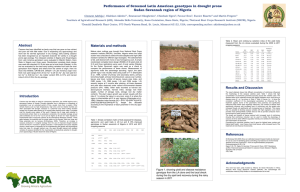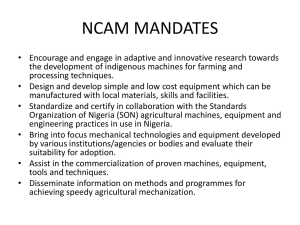Scientific papers
advertisement
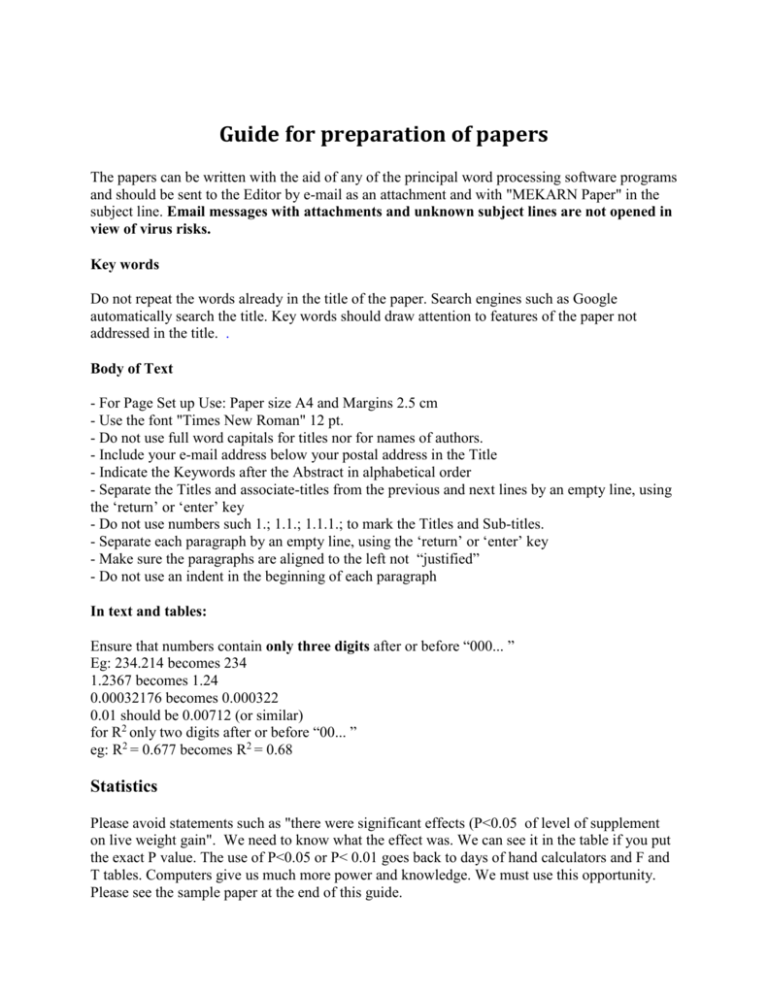
Guide for preparation of papers The papers can be written with the aid of any of the principal word processing software programs and should be sent to the Editor by e-mail as an attachment and with "MEKARN Paper" in the subject line. Email messages with attachments and unknown subject lines are not opened in view of virus risks. Key words Do not repeat the words already in the title of the paper. Search engines such as Google automatically search the title. Key words should draw attention to features of the paper not addressed in the title. . Body of Text - For Page Set up Use: Paper size A4 and Margins 2.5 cm - Use the font "Times New Roman" 12 pt. - Do not use full word capitals for titles nor for names of authors. - Include your e-mail address below your postal address in the Title - Indicate the Keywords after the Abstract in alphabetical order - Separate the Titles and associate-titles from the previous and next lines by an empty line, using the ‘return’ or ‘enter’ key - Do not use numbers such 1.; 1.1.; 1.1.1.; to mark the Titles and Sub-titles. - Separate each paragraph by an empty line, using the ‘return’ or ‘enter’ key - Make sure the paragraphs are aligned to the left not “justified” - Do not use an indent in the beginning of each paragraph In text and tables: Ensure that numbers contain only three digits after or before “000... ” Eg: 234.214 becomes 234 1.2367 becomes 1.24 0.00032176 becomes 0.000322 0.01 should be 0.00712 (or similar) for R2 only two digits after or before “00... ” eg: R2 = 0.677 becomes R2 = 0.68 Statistics Please avoid statements such as "there were significant effects (P<0.05 of level of supplement on live weight gain". We need to know what the effect was. We can see it in the table if you put the exact P value. The use of P<0.05 or P< 0.01 goes back to days of hand calculators and F and T tables. Computers give us much more power and knowledge. We must use this opportunity. Please see the sample paper at the end of this guide. Also when discussing treatment differences: Treatment differences are considered significant at P< 0.05 and trends are discussed at P< 0.10 P>0.05 eg:: “Treatment CF1 was greater than treatment CTL” [no need to write (P<0.05) as this is understood and the actual value (eg: P=0.043) will be in the table of results]. But ”there was a tendency for treatment CF1 to be greater than treatment CTL (P=0.065)” In this case the exact value of P is given so that the reader can appreciate the degree of confidence in the expressed difference. When presenting probability values, you should give the exact value (eg: P=0.057), but if your computer program only gives 2 or 3 numbers after the decimal (eg P 0.001) you should write P <0.001). Graphics: Where possible, please always supply in Excel or Open Office Calc the original spreadsheets including graphs and data which were used to produce graphics in the papers, since this allows us to produce a uniform look and maintain the quality of the finished publication. Within the graphics Font should be: Arial – Regular – 10 pt. Tables: Please format them using the Table menu, and not Tabs and Spaces - when using the tabular format please allot a new cell to each piece of data. - include the title of the table as well as the notes at the bottom of table inside the Table itself not in the body of the text. Example: Preparing the table in Microsoft Word: Table 7: Mean values for gasifier characteristics using coconut shells-husks, cassava stems, mulberry stems and branches of Cassia stamea as feedstock Cassia Cassava Mulberry Coconut SEM Prob. Initial 36.7 32.3 33.7 34.4 1.3 0.21 Final 4.93 1.9 0 3.07 2.19 0.49 Biomass, kg Consumption Moisture, % 36.9 35.1 40 14 13.3 15.7 c b 36.4 2.9 0.69 14 1.4 0.69 10.4 0.001 Density, g/litre 348 a 97.0 Duration, h 3.91 3.67 4.09 4.02 0.328 0.81 Output, kwh 27.4 25.7 28.7 28.2 2.29 0.81 273 128 c Conversion# 1.23 1.18 1.18 1.11 0.044 0.42 Efficiency## 0.187 0.204 0.204 0.217 0.0082 0.17 Biochar, g/kg biomass DM 109 128 109 137 16.5 0.58 # kg dry biomass/kwh; ## Assumes 15 MJ/kg biomass DM and 3.6 MJ/kwh of electricity abc Means in the same row without common letter are different at P<0.05 Creating the final version of the table by eliminating the unnecessary lines and borders: Table 7: Mean values for gasifier characteristics using coconut shells-husks, cassava stems, mulberry stems and branches of Cassia stamea as feedstock Cassia Cassava Mulberry Coconut SEM Prob. Initial 36.7 32.3 33.7 34.4 1.3 0.21 Final 4.93 1.9 0 3.07 2.19 0.49 Consumption 36.9 35.1 40 36.4 2.9 0.69 14 13.3 15.7 14 1.4 0.69 c b 10.4 0.001 Biomass, kg Moisture, % Density, g/litre 348 a 97.0 Duration, h 3.91 3.67 4.09 4.02 0.328 0.81 Output, kwh 27.4 25.7 28.7 28.2 2.29 0.81 Conversion# 1.23 1.18 1.18 1.11 0.044 0.42 Efficiency## 0.187 0.204 0.204 0.217 0.0082 0.17 273 128 c Biochar, g/kg biomass DM 109 128 109 137 16.5 0.58 # kg dry biomass/kwh; ## Assumes 15 MJ/kg biomass DM and 3.6 MJ/kwh of electricity abc Means in the same row without common letter are different at P<0.05 References: In the text, do not put a ‘comma’ between the name and the date. Do not put a ‘dot’ after ‘et al’. “et al” should be in regular font, not in italics. Example: (Gueye et al 1998) Citations in the reference list should be set up with minimum punctuation but maximum detail of the actual citation. Names of authors and the date are in bold font. Abbreviations, in particular of journal titles, should not be used. In the list of references, citations should include the appropriate "URL" for the article, when this URL is freely accessible. For example: Cerón-Muñoz M F, Tonhati H, Costa C N, Rojas-Sarmiento D and Solarte Portilla C 2004 Variance heterogeneity for milk yield in Brazilian and Colombian Holstein herds. Livestock Research for Rural Development, Volume 16, Article #20 Retrieved June 1, 2004, from http://www.lrrd.org/lrrd16/4/cero16020.htm Many Journals are at present accessible on the Web (do not indicate the URL of Journals that need a subscription or a payment!!). Here is a list (not limitative) of some Journals freely available: Livestock Research for Rural Development: http://www.lrrd.org/ Tropical Animal Production: http://www.utafoundation.org/tapindex.htm Journal of Animal Science: http://jas.fass.org/ (for issues that appeared more than one year earlier!) Journal of Dairy Science: http://jds.fass.org/ (for issues that appeared more than one year earlier!) Annales de Zootechnie (accessible through Animal Research site) Animal Research: http://animres.edpsciences.org/ Pakistan Journal of Nutrition: http://www.pjbs.org/pjnonline/ Revista Brasileira de Zootecnia: http://www.scielo.br/scielo.php?script=sci_serial&pid=1516-3598&lng=en&nrm=iso Revista Brasileira de Saúde e Produção Animal: http://revistas.ufba.br/index.php/rbspa/issue/archive Archivos de Zootecnia: http://www.uco.es/organiza/servicios/publica/az/php/az.php Most of FAO (http://www.fao.org) publications and FAO/IAEA (http://www-naweb.iaea.org/nafa/index.html) publications Check that this URL is complete (it means that it leads directly to the article, not to the Journal Home Page), is correct and functioning by clicking on it: it should lead you to the Web site.! PLEASE: Use the Spell-Check tool in order to correct any spelling mistake, and Ensure that references in the text are in the reference list and vice versa. Read and follow this guide Check the following link for an article with the correct formating. http://www.lrrd.org/lrrd23/2/sang23021.htm An easy way to check the reference list is to print it, and then from the beginning of the text use the "FIND" command and type "19" and then "20". This will locate all the references assuming you have cited correctly the source including the date. The reviewers appreciate the pressure put on academics to publish in order to maintain their positions. This very pressure should, however, encourage authors to be more rigorous in their presentation. If they evince a lack of interest in accuracy they should not expect that increasingly frustrated referees, giving freely of their time and experience, should contain their frustrations and make the paper accurate for them. Proof reading of papers: Each paper as it is edited is being made available as a provisional "url" which is communicated to authors when the final version of their paper is ready in html format. Authors can then check the paper for possible errors or last minute corrections and inform the editors accordingly. Queries on the proofs made by the editors are indicated in "red" (suggested rejection) or "blue" (suggested additions or changes). Authors sending corrections to the proofs should send an email to the Editor in the following format: data / text to be replaced should be written in "red" font new data / text should be written in "blue" font Do not send a copy of the whole paper as this would require the editors repeating the whole process of conversion to HTML format, which can be quite time-consuming. Finally Use the template attached to this article as a guide to the font size for the Headings. The procedure is as follows. First “block” the whole of your present document, copy the document, then “paste” the document at the beginning of the template. Delete the rest of the template. Save the document with yr “abbreviated” name and data (eg: thu120216). THEN: Format your “new” document For MS Word versions 2007 and 2010 the headings are indicated in the menu at the top of the page Eg: For Word 93, click on “format” on the menu at top of page, click on “Styles and formatting”. A menu will appear in the right margin. Scroll down to the part that begins with Headings. Title is Heading 1 Authors Heading 2 Address (including email) Heading 3 Main sections (eg: Abstract, Introduction …) are in Heading 4 Key words are in Heading 6 Sub-sections (eg: Experimental design…) are in Heading 5 Sub-sub-sections are in Heading 6 The template follows from here (next page) Effect of levels of sun-dried cassava foliage on growth performance of cattle fed rice straw Keo Sath, Khieu Borin and T R Preston* CelAgrid, Cambodia keosath@celagrid.org * Finca Ecológica,UTA-Colombia, AA#48, Socorro, Santander, Colombia Abstract An on-farm trial experiment was carried out in Treang district, Takeo province from June to September 2006. Twenty female cattle were allocated to five levels of sun-dried cassava foliage (0, 0.25, 0.5, 0.75 and 1 % of body weight in DM basis) to evaluate the growth response when fed a basal diet of untreated rice straw plus a rumen supplement. The heifers were tethered alongside the feed trough in each household, where they had free access to the experimental diet and water. The heifers were provided rumen supplement (mainly urea, sulphur and other minerals) at 0.25% body weight and ad libitum rice straw. The design was a completely randomized design (CRD) with four replications of each treatment. The intake of the leaf component of the cassava was 90% of the offer but only 45% of the offer level of petiole was consumed. The total intake of DM and crude protein intake increased according to the intake of cassava foliage. Daily weight gain increased from 201 to 402 g/day and feed conversion was better with increasing levels of protein from sun-dried cassava foliage in the diet. The responses were linear over the range of cassava crude protein intakes from 0 to 1.6 g/kg live weight. It is concluded that supplementation with sun dried cassava foliage stimulated the growth performance of cattle and that the response was linear over the range from 0 to 1.6g cassava crude protein/kg live weight. Key words: On-farm trial, parasites, rumen supplement, Introduction Similar with other developing countries in the region, large ruminants in Cambodia depend on natural pasture and crop residues, mainly rice straw. These are of low digestibility and usually imbalanced in essential nutrients which contribute to low feed intake (Schiere and Ibrahim 1989). Supplements are required to improve rumen microbial fermentation and therefore the performance of the host animals (Dixon and Egan 1987). Inadequate nutrition in cattle has often caused economic loss to the farmers because their animals loose weight and body condition, resulting in reduced reproductive capacity and increased susceptibility to diseases and parasites (Leng 1997). Early work with fresh cassava leaves showed that it could be the sole source of supplementary protein and roughage in diets for fattening cattle based on liquid molasses-urea (Ffoulkes and Preston 1978). When used as a supplement to untreated rice straw the growth rates in ‘local “yellow” cattle were increased threefold by supplementing them with fresh cassava foliage (Seng Mom et al 2001). Ho Quang Do et al (2002) reported a curvilinear increase in N retention in goats when fresh cassava leaves replaced grass as the supplement to ammoniated rice straw. In Cambodia, cassava (Manihot esculenta) is usually planted by the farmers with the main purpose of root harvesting and the leaves are left in the field. It has been shown that this residue can be a valuable source of protein for feeding to many kinds of animals (Preston 2001). When farmers harvest cassava root, the leaves are still a good quality protein feed for cattle particularly in the dry season. This situation can give an opportunity for farmers to get more benefit by collecting the cassava leaves for cattle feeding. Therefore, it is important to promote ways of maximizing the use of this valuable crop. Wanapat et al (1997) have drawn attention to the potential of cassava foliage made into hay, which combined leaves, stems and petiole, as a feed for ruminants. Added to this, cassava foliage contains condensed tannins (Wanapat et al 1997), which when fed to buffaloes in form of sun dried hay (Netpana et al 2001; Granum et al 2002) and goats (Seng sokerya and Preston 2003) in fresh form has been reported to reduce nematode egg counts. In view of the potential of cassava foliage as a supplement for ruminant animals, there is a need to promote research with this feed for cattle in the Cambodia situation. Objectives To study effect of levels of sun dried cassava foliage on growth performance of cattle fed rice straw To study effect of sun dried cassava foliage on faecal nematode egg counts To introduce to farmers the idea of using cassava foliage for their animals Materials and Methods Location and duration The experiment was carried out in villages in Treang district, Takeo province which is about 80 km south of Phnom Penh city. The experiment was conducted for 3 months from June to September 2006 excluding adaptation and organizing period. Farmer selection In Treang district, Takeo provice, CelAgrid has been implementing a cattle project financed by Heifer International Cambodia. The aims of the implementation are to improve cattle management and feeding. Twenty farmers (including women householders) were selected for the study to evaluate the response to sun-dried cassava foliage. Beside these farmers, seven other farmers joined in the study to serve as controls using the traditional system of un-supplemented free grazing treatment. The selection of the farmers was based on: Having Heifers of 1.5 to 2 years of age Availability of land for growing cassava foliage Willingness to participate in the research and strong commitment to the idea Willingness to share technologies with neighbors Experimental design The experimental design was a “production function” to evaluate the growth response of cattle to increasing levels of sun-dried cassava foliage when fed untreated rice straw plus a “rumen supplement”. One female animal per household (n=20) was allocated to one of 5 levels of sun dried cassava foliage (0, 0.25, 0.5, 0.75 and 1 % of body weight in DM basis). The design was a completely randomized design (CRD) with 4 replications of each treatment. The individual treatments were - RC0: Rice straw + rumen supplement at 0.25% body weight - RC0.25: Rice straw + rumen supplement 0.25% body weight + sun dried cassava foliage 0.25% body weight (in DM) - RC0.50: Rice straw + rumen supplement 0.25% body weight + sun dried cassava foliage 0.50% body weight (in DM) - RC0.75: Rice straw + rumen supplement 0.25% body weight + sun dried cassava foliage 0.75% body weight (in DM) - RC1: Rice straw + rumen supplement 0.25% body weight + sun dried cassava foliage 1% body weight (in DM) Animals and management The heifers were vaccinated against Foot and Mouth Disease before starting the experiment. They were from 1.5 to 2 years of age with an average live weight of 174 kg live weight. Twenty heifers were tethered alongside the feed trough (Photo 1) in each household, where they had free access to the experimental diet. The sun-died cassava foliage was fed first at about 7.00 am. The rumen supplement and rice straw were fed 2 times per day in the morning (8:00h) and afternoon (16:00h). Water was available the whole day. The seven “control” heifers were kept under traditional farmer management of free grazing and no supplementation. Photo 1: Individual animals tethered to the feed trough in each household Experimental Feeding The cassava foliage was bought from farm households situated along the riverside in Kandal province, at the time of harvesting the roots. It was taken to CelAgrid for drying. The cassava leaves plus petioles were separated from the hard stem and sun dried by spreading on a plastic sheet placed on the ground. The duration of sun drying was 3 to 5 days until the leaves become crisp (>85%DM). After sun drying, the foliages were stored in bags and transported to the study site in Takeo province. The ingredients for the rumen supplement (Table 1) were bought at the local market and mixed by the farmers participating in the study (Photo 2). After mixing, it was kept by each farm household and fed to the cattle at the rate of 0.25% of body weight per day. Rice straw was bought from farmers in the study area. It was from rice grown under rain-fed conditions. Table 1: Composition of the rumen supplement Ingredient % (fresh basis) Sugar palm syrup 27 Water 13 Rice bran 33.5 Urea 13 Diammonium phosphate 3 Salt 5 Lime 5 Sulfur 0.5 Photo 2: Farmers preparing the rumen supplement Data collection Feeds offered and refused were recorded daily and weighed to measure daily feed intake. Representative samples of feeds offered and refused were collected for chemical analysis. The live weight was taken at the beginning of the study and then every 2 weeks until the end of the trial (Photo 3). Faecal samples were collected directly from the rectum of each animal once at the beginning of the experiment and after every 2 week interval to check the nematode egg count. Photo 3: the method of weighing the cattle Chemical analyses The feeds offered and refused were analyzed for DM using microwave radiation (Undersander et al 1993) and N following the Kjeldahl procedure as outlined by AOAC (1990). For faecal egg counts, 4 g of representative samples of faeces were ground and mixed with 56 ml of floatation fluid (a saturated salt solution in water). A sub sample was transferred to both compartments of a McMaster counting chamber and allowed to stand for 5 minutes. All helminth eggs were counted under a microscope at 10x10 magnification and multiplied by 50 to yield the eggs per gram of faeces (Hansen and Perry 1994). Statistical analysis Data for feed intake, growth and feed conversion were analyzed by analysis of variance (ANOVA) using the General Linear Model procedure of MINITAB software (Version 13.31 2000). Sources of variation were levels of sun dried cassava foliage and error. Regression analysis was used to relate the independent variable (levels sun dried cassava foliage) with the dependent variables (live weight gain, feed intake and feed conversion). Results and discussion Animal health There were no signs or symptoms of disease or toxicity in the animals during the experiment. Animals were in good healthy and it was observed that the skin became brighter in colour towards the end of the experiment, especially in the treatments with highest offer levels of cassava foliage. The changing appearance of the skin observed in this study may have been due to the effect of the protein supplementation enhancing the expression of immunity against internal and external parasite (Leng R A. personal communication). Chemical composition of diet The chemical composition of the components of the sun-dried cassava foliage, and of the rumen supplement, are shown in tables 2 and 3. The crude protein level in the cassava leaves was almost three times higher in the leaves than in the petioles. It was lower than in the studies of Wanapat (2003) and Vongsamphanh and Wanapat (2004) where the values reported were 23.6% and 27.3% in DM. These higher values could be because these authors harvested the foliage 3 months after planting, whereas the sun-dried cassava foliage in this study was collected at root harvesting. The nutritive value of cassava foliage has been shown to be affected by variety, location, soil type and other environmental conditions as well as the method of chemical analysis (Seerley 1972). Table 2: Mean values for chemical composition of feed ingredients % DM Whole sun dried cassava foliage N*6.25, % in DM 87 18.8 Sun dried cassava leaves 88.7 23.4 Sun dried cassava petiole 86.3 9.7 Rumen supplement 70.6 39.6 The DM and crude protein of the rice straw varied slightly among the different households (Table 3). The mean overall values were 87.1% DM and 5.41% crude protein. Table 3: Mean values for chemical composition of rice straw in the different households Family name % DM N*6.25, % (in DM) Mr. Banh Keo 85.6 5.8 Mr. Chham Kosal 85.5 4.9 Mrs. Eth Sarom 87.5 5.1 Mr. Im Ean 88.0 5.1 Mr. Khat Youn 88.3 4.9 Mr. Kim Cho 86.3 5.7 Mr. Kong Thol 87.5 4.9 Mr. Moa Khon 88.4 5.7 Mrs. Moa Yat 85.7 5.8 Mr. Ngan Thy 85.8 5.7 Mrs. Nhem That 86.3 5.7 Mrs. Nhem Theoun 87.3 5.7 Mr. Ni Chivo 87.5 4.9 Mrs. Oam Rani 86.6 4.9 Mrs. Om Yen 88.0 5.1 Mrs. Sok Chanthy 88.0 5.8 Mrs. Sok Mali 88.3 5.1 Mrs. Sok Min 85.9 5.8 Mrs. Thou Ka 86.8 5.8 Mrs. Yong Thuch 87.8 5.7 Mean±SD 87.1±1.01 5.41±0.39 Feed intake The actual intake of the supplements was lower than the planned offer levels (Table 4; Figure 1). The heifers selected the cassava leaves in preference to the petioles, such that intakes of the former were 90% of the offer levels while for the latter it was less than 45% of offer levels. The low acceptability of the sun-dried petioles may be due to the effect of drying (rather hard in texture) or the lower protein content. In this study, leaves and petioles were sun-dried without chopping. In contrast, when feeding fresh cassava foliage managed by repeated harvesting there was no selection (personal observation) against the petioles. The cattle consumed petioles, leaves and soft stems but refused the hard stems. Table 4: Actual intake of sun dried cassava foliage compared with planned levels 0 0.25 Planned, % of body weight (DM) Actual intake,% body weight (DM) 0 0.18 Intake as % amount offered Cassava leaf 0 96.7 Cassava petiole 0 40.1 Crude protein, g/g total CP in diet 0 0.16 Rice straw Rumen supplement Cassava leaf 0.5 0.34 0.75 0.55 1 0.73 95.7 30.3 0.26 94.9 44.2 0.38 96.0 39.4 0.43 Cassava petiole Intake as % of amount offered 100 90 80 70 60 50 40 30 20 10 0 0 0.25 0.5 0.75 1 Offer of sun-dried cassava foliage, kg DM/100kg live weght Figure 1: Mean values for intake of diet ingredients as % of amount offered according to the offer level of sun-dried cassava foliage There were no significant effects of cassava foliage intake on DM and crude protein intake of rice straw and rumen supplement (Table 5). However, total intake of DM and crude protein intake increased according to the intake of cassava foliage (Figures 2 and 3). The total DM increased by 30% and the crude protein by 65% at the highest level of cassava foliage. The proportion of dietary crude protein from sun dried cassava foliage was 40% of the total crude protein intake at the highest level of supplementation (Figure 4). The effect of the sun-dried cassava foliage in increasing the total DM intake in this study is in agreement with reports by Vongsamphanh and Wanapat (2004), who supplemented rice straw with cassava hay in a study with cattle, and by by Ho Quang Do et al (2002) who supplemented fresh cassava foliage to goats fed ammoniated rice straw. The positive linear trend in total DM intake in response to the supplementary cassava foliage protein (Figure 5) is in accordance with the thesis outlined by Leng and Preston (1976) and by IAEA (2002) that the selected protein supplement should not reduce intake and utilization of the basal diet but instead have potential to enhance them. Table 5: Mean values for feed intake and crude protein intake of heifers fed rice straw with levels of sun dried cassava foliage Planned levels of cassava, % of live weight (DM basis) 0 0.25 0.5 0.75 1 SEM P DM intake, g/day Rice straw 4295 4156 4538 3967 4336 224 0.49 Rumen supplement 315 293 303 258 309 18.5 0.26 Cassava 0 323 621 994 1305 Total 4609c 4772c 5462bc 5219bc 5950ab 234 0.001 DMI, g/kg LW 25.6 27.0 30.1 29.2 32.8 1.97 0.14 CP intake, g/day Rice straw 245 223 243 213 224 16.7 0.62 Rumen supplement 125 116 120 102 122 7.32 0.26 Cassava 0 64.7 127 196 261 Total 369d 404cd 490bc 511b 608a 20.8 0.001 7000 Rice straw Rumen supplement Cassava foliage Intake, g DM/day 6000 5000 4000 3000 2000 1000 0 0 0.37 0.69 1.09 1.43 Crude protein from cassava foliage, g / kg live weight Figure 2: Mean values for intake of diet ingredients according to intake of crude protein from sun-dried cassava foliage 700 Rice straw Rumen supplement Cassava foliage Intake crude protein, g/day 600 500 400 300 200 100 0 0 0.37 0.69 1.09 1.43 Crude protein from cassava foliage, g / kg live weight Figure 3: Mean values for intake of crude protein from the different dietary ingredients according to intake of intake of crude protein from sun-dried cassava foliage Rice straw Rumen supplement Cassava foliage 100% 90% 80% 70% 60% 50% 40% 30% 20% 10% 0% 0 0.37 0.69 1.09 1.43 Crude protein from cassava foliage, g / kg live weight Figure 4: Mean values for percentage of dietary crude intake from the different ingredients according to intake of crude protein from sun-dried cassava foliage 7000 y = 883x + 4569 R2 = 0.52 P=0.001 DM intake, g/day 6500 6000 5500 5000 4500 4000 0 0.5 1 1.5 2 Crude protein from cassava, g/kg live weight Figure 5: Relationship between sun-dried cassava foliage intake and DM intake Growth rate There were major differences in live weight gain between the heifers fed rice straw and rumen supplement (without cassava foliage) and those on un-supplemented free grazing (Figure 6). The rumen supplement provided nutrients for rumen microbes (ammonia, sulphur, phosphorus and other minerals) that can correct deficiencies of these nutrients in poor quality feeds such as rice straw. It cannot be concluded that the difference was due only to the rumen supplement as the grazing areas were extremely limited due to the land being used for the rice crop. The daily weight gain of the cattle fed only rumen supplement and straw in this experiment was higher than in the study of Seng Mom et al (2001); however, there were differences in the breeds which were larger and of Zebu type in our study compared with the smaller “Yellow” breed of cattle used by Seng Mom et al (2001). 300 Live weight gain. g/day 250 200 150 100 50 0 -50 Free grazing Rice straw + rumen supplement -100 Figure 6: Comparison of rice straw + rumen supplement (without cassava) and free grazing on live weight gain Daily weight gain increased and feed conversion was better with increasing levels of protein from sun-dried cassava foliage in the diet (Table 6). The responses (Figures 7 and 8) were linear over the range of cassava crude protein intakes recorded in the experiment (from 0 to 1.6 g crude protein/kg live weight). The improved growth rates and feed conversion in this study are in agreement with the reports of Seng Mom et al (2001) and Ho Quang Do et al (2001), who used fresh cassava foliage as a supplement for cattle fed rice straw and Moore, (1976) who gave cassava foliage to steers fed Pennisetum purpureum with varying levels of cassava foliage. Le Huu Khoung and Duong Nguyen Khang (2005) reported a linear increase in live weight gain in “Sindhi* Yellow” cattle fed fresh cassava foliage as a supplement to urea-treated rice straw. The maximum response of 60% was less than the 200% response in our study probably because the rate of cassava foliage supplementation was higher (1.6 g/kg live weight compared with 1.0 g/kg live weight in the study of Le Huu Khoung and Duong Nguyen Khang (2005). The response in the experiment of Seng Mom et al (2001) was 400% for cassava foliage protein at 1.3 g/kg live weight compared with the control. The results of this study, together with the numerous reports in the literature, indicate strongly that the beneficial effect in ruminants of the protein in cassava foliage is due to its “ bypass” or “ escape’’ properties presumably because of the binding effect on the protein of the tannins present in this forage (Wanapat et al 1997). In an in vitro study, Promkot and Wanapat (2003) estimated that the rumen undegradable protein (assumed to be bypass protein) as percent of total protein in cassava hay was 52.7 compared with 50.4 for cottonseed meal (considered to be one of the best sources of bypass protein according to Preston and Leng 1987) and 35 for leucaena leaf meal. Table 6: Mean values for live weight and conversion of heifers fed rice straw with levels of sun dried cassava foliage Planned levels of cassava, % of live weight (DM basis) 0 0.25 0.5 0.75 1 SEM P Live weight, kg Initial 175 166 170 168 166 8.88 0.93 Final 191 189 196 192 199 9.24 0.93 Final# 185 192 195 193 202 3.50 0.058 b ab ab ab a Daily gain, g/day 201 266 282 278 402 33.0 0.01 25.1 18.4 20. 18.8 15.0 2.39 0.09 Feed DM conversion # Adjusted for differences in initial weight y = 113x + 205 R2 = 0.45 P=0.001 Live weight gain, g/day 600 500 400 300 200 100 0 0 0.5 1 1.5 2 Crude protein from cassava, g/kg live weight Figure 7: Relationship between protein from sun-dried cassava foliage intake (as g/kg live weight) and live weight gain Live weight gain, g/day 600 y = 347x + 200 R2 = 0.40 P=0.003 500 400 300 200 100 0 0 0.1 0.2 0.3 0.4 0.5 Crude protein from cassava, g/g total protein intake Figure 8: Relationship between protein from sun-dried cassava foliage (as proportion of total crude protein intake) and live weight gain DM feed conversion 30 y = -5.34x + 23.4 R2 = 0.27 P=0.019 25 20 15 10 5 0 0.25 0.5 0.75 1 1.25 1.5 1.75 Crude protein from cassava, g/kg live weight Figure 9: Relationship between intake of crude protein from sundried cassava foliage and DM feed conversion Parasite egg count The numbers of nematode eggs in the faeces were extremely low both in the supplemented cattle and those on free grazing with no obvious tendencies due to date of sampling or supplementation (Table 7). Table 7: Nematode egg counts/g of faeces in the heifers fed rice straw and sun-dried cassava foliage or on free grazing Crude protein from cassava foliage, g/kg live weight Sample date 0 0.37 0.69 1.09 1.43 Free grazing 6/27/2006 275 188 238 200 425 243 7/11/2006 138 150 225 150 188 143 7/25/2006 238 250 275 375 175 193 8/8/2006 150 125 466 213 225 171 8/22/2006 213 100 325 163 288 171 9/5/2006 163 88 225 88 150 179 9/19/2006 200 75 138 100 163 229 Conclusions Based on the results of this research it is concluded that: Increasing levels of sun dried cassava foliage led to significant increases in total dry matter intake and daily weight gain of cattle fed untreated rice straw and a rumen supplement The response to cassava foliage protein in cattle fed untreated rice straw and rumen supplement is linear over the range of 0 to 1.6 g crude protein/kg live weight. Sun dried cassava foliage is a good source of bypass protein source for cattle Acknowledgements The authors are grateful to the MEKARN project, financed by the Sida-SAREC agency and my assistants Mr. Pek Samnang and Chea Chheangly for their technical help. Thanks are also due to 27 farmers in Treang District, Takeo province, who shared their experiences and participated actively in this study. References AOAC 1990 Official Method of Analysis. Association of Official Analytical Chemists. 15 th edition (K Helrick editor). Arlington pp 1230 Dixon R M and Egan A R 1987 Strategies for utilization fibrous crop residues as animal feeds, Paper presented to the 7th AAFARR workshop, Chaing Mai, Thailand Ffoulkes D and Preston T R 1978 Cassava or sweet potato forage as combined sources of protein and roughage in molasses based diets: effect of supplementation with soybean meal. Tropical Animal Production (3): 186-192 Granum G, Wanapat M, Wachirapakorn C and Pakdee P 2002 The effect of cassava hay supplementation on weight change, dry matter intake, digestibility and internal parasites in swamp buffaloes (bubalus bubalis) and cattle (bos indicus). In: Proc. Agriculture Conference, Narasuan University, Pitsanuloke, Thailand, July 26-30. Hansen Jørgen and Perry Brian 1994 The epidemiology diagnosis and control of helminth parasites of ruminants. A Handbook, International Laboratory for Research on Animal Diseases, Nairobi, Kenya Ho Quang Do, Vo Van San and Preston T R 2001 Blocks or cakes of urea-molasses as supplement for Sindhi x Yellow cattle fed rice straw and cut grass or cassava foliage. In: Proc. International Workshop on Current Research and Development on Use of Cassava as Animal feed. (Eds, T R Preston, B Ogle and M Wanapat), organized by Khon Kaen University and SIDA-SAREC, Sweden. July 23-24, 2001 Ho Quang Do, Vo Van Son, Bui Phan Thu Hang, Vuong Chan Tri and Preston T R 2002 Effect of supplementation of ammoniated rice straw with cassava leaves or grass on intake, digestibility and N retention by goats. Livestock Research for Rural Development (14) 3: http://www.lrrd.org/lrrd14/3/do143b.htm IAEA 2002 Development and Field Evaluation of Animal feed supplementation Packages. Proceeding of the final review meeting of an IAEA Technical co-operation regional AFRA project. Vienna 2002 IAEA Le Huu Khoung and Duong Nguyen Khang 2005 Effect of fresh foliage on growth and faecal nematode egg counts in Sindhi X Yellow cattle fed urea-treated rice straw basal diet. In: Proc. Regional seminar workshop on livestock based sustainable farming systems in the lower Mekong Basin. (Eds, T R Preston, B Ogle) organized by Cantho University, Vietnam and Sida-SAREC, Sweden. May 23-25, 2005 Leng R A 1997 Tree foliage in ruminant nutrition. http://www.fao.org/docrep/003/w7448e/w7448e00.htm Leng R A and Preston T R 1976 Sugarcane for cattle production: present constraints, perspectives and researchpriorities. Tropical Animal Production 1: 1–22 Netpana N, Wanapat M, Poungchompu O and Toburan W 2001 Effect of condensed tannins in cassava hay on fecal parasitic egg counts in swamp buffaloes and cattle. In: Proceedings International Workshop on Current Research and Development on Use of Cassava as Animal Feed. T R Preston, B Ogle and M Wanapat (Ed) http://www.mekarn.org/procKK/netp.htm Moore C P 1976 The utilization of cassava forage in ruminant feeding. International Seminar on Tropical Livestock Products, 8-12 March, Acapulco, Mexico. Preston T R 2001 Potential of cassava in integrated faming systems. In: Proc. International Workshop on Current Research and Development on Use of Cassava as Animal feed. (Eds, T R Preston, B Ogle and M Wanapat), organized by Khon Kaen University and SIDA-SAREC, Sweden. July 23-24, 2001 Preston T R and Leng R A 1987 Matching Ruminant Production System with Available Resource in the Tropic and Subtropics. PENAMBUL BOOKS: ARMIDALE, P.O.Box 512, Armidale, New South Wales 2350, Australia. Promkot C and Wanapat M 2993 Ruminal degradation and intestinal digestion of crude protein of tropical resources using nylon bag technique and three-step in vitro procedure in dairy cattle. Livestock Research for Rural Development (15) 11. http://www.lrrd.org/lrrd15/11/prom1511.htm Schiere J B and Ibrahim M N M 1989 Feeding of urea-ammonia treated rice straw. A compilation of miscellaneous reports produce by the Straw Utilization Project (Sri Lanka): 9. 101 Seerley R W 1972 Utilization of cassava as a livestock feed. Pages 99-130 in Literature review and research recommendations on cassava, edited by C.H. Hendershott et al., AID Contract no. csd/2497. University of Georgia, Athens, USA. Seng Mom, Preston T R, Leng R A and Meulen Uter 2001 Response of young cattle fed rice straw to supplementation with cassava foliage and a single drench of cooking oil. Livestock Research for Rural Development (13) 4. http://www.lrrd.org/lrrd13/4/seng134.htm Seng Sokerya and Preston T R 2003 Effect of grass or cassava foliage on growth and nematode parasite infestation in goats fed low or high protein diet in confinement. Livestock Research for Rural Development (15) 8: http://www.lrrd.org/lrrd15/8/kery158.htm Undersander D, Mertens D R and Theix N 1993 Forage analysis procedures. National Forage Testing Association. Omaha pp 154 Vongsamphanh P and Wanapat M 2004 Comparison of cassava hay yield and chemical composition of local and introduced varieties and effects of levels of cassava hay supplementation in native beef cattle fed on rice straw. Livestock Research for Rural Development 16 (8): http://www.lrrd.org/lrrd16/8/cont1608.htm Wanapat M 2003 Manipulation of cassava cultivation and utilization to improve protein to energy biomass for livestock feeding in tropic. Asian-Aus J Anim Sci 16, 463-472 Wanapat M, Pimpa O, Petlum A and Boontao U 1997 Cassava hay: A new strategic feed for ruminants during the dry season. Livestock Research for Rural Development (9) 2: http://www.lrrd.org/lrrd9/2/metha92.htm Return to top


